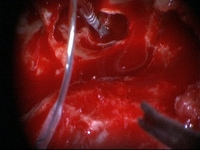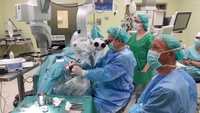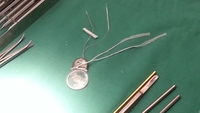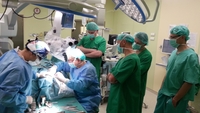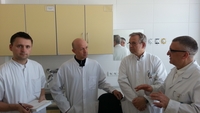Therapeutic success at the MUG Department of Otoaryngology
25.04.2013
On April 22nd 2013, the MUG Department of Laryngology headed by prof. Czesław Stankiewicz began a new clinical program to treat deafness using cochlear implants. The Cochlear Implant Team at the Department consists of prof. Jerzy Kuczkowski, dr Wojciech Sierszeń, dr Tomasz Przewoźny, lek. Andrzej Molisz, lek. Karolina Markiet, dr hab. Edyta Szurowska as well as speech-language therapists and psychologists from the Gdańsk Center for the Diagnosis & Rehabilitation of Children & Youth with Hearing Impairment (part of the Polish Association of the Deaf), headed by Dorota Szubstarska MSc. Their first patient was a 36-year-old man with bilateral deafness. The operation was supervised by prof. Kazimierz Niemczyk from the Otolaryngology Clinic at the Medical University of Warsaw and a team of biomedical engineers from the Medicus company. The operation ended without any complications and was successful. MUG is now o ne of the few centers in POland where a cochlear implant procedure is performed.
A cochlear implant is an electronic device that replaces the patient’s damaged hearing organ, the cochlea. The purpose of the implant is to electrically stimulate the cochlear nerve endings. The CI System (Cochlear Implant) consists of the implanted part (receiver and electric stimulator with electrodes) and external part (speech processor and antenna). The speech processor uses a programmed code (usually the CIS, Continuous Interleaved Sampling) to divide the speech signal into wavelengths and convert into digital signal which is then transmitted using radio waves to the receiver which is embedded in the skin outside the ear. At this time the Department is implaning a 22-channel system Nucleus Contour Advance manufactured by the Cochlear company. The main indications for cochlear implant surgery is a severe-to-profound sensorineural perceptive hearing loss and no benefit from hearing aids. Due to the complexity of the surgery, the patients are qualified by a team consisting of a speech therapist, psychologist, audiologist, radiologist, biomedical engineer and otosurgeon. The surgical procedure consists of performing a cochleostomy via lower tympanotomy and attaching a 22-channel electrode to the scalae of the cochlea. 4 weeks after the surgery, the speech processor is connected and the patient begins rehabilitation.
For the last 5 years, the Department has been successfully treating profound hearing loss using the BAHA (Bone Anchored Hearing Aid) method in patients who had no benefit from traditional hearing aids or tympanoplasty operations. The BAHA system consists of an titanium implant into the temporal bone and an external receiver/processor which converts sounds into vibrations that are transmitted into the implant. Implementation of these methods will allow the Department to more effectively treat the hearing impairments among children and adults.
Archives
- Academic Year 2024/2025
- Academic Year 2023/2024
- Academic Year 2022/2023
- Academic Year 2021/2022
- Academic Year 2020/2021
- Academic Year 2019/2020
- Academic Year 2018/2019
- Academic Year 2017/2018
- Academic Year 2016/2017
- Academic Year 2015/2016
- Academic Year 2014/2015
- Academic Year 2013/2014
- Academic Year 2012/2013
